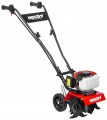Working width
The maximum width of the strip of land processed by the machine in one pass.
The large width makes it easier to work in large open areas, allowing them to be dealt with faster. At the same time, it is easier to deal with bottlenecks and hard-to-reach nooks and crannies with a small working width — a large unit may simply not fit where a smaller one will pass without problems. So it is worth choosing according to this indicator, taking into account the features of the planned work. If we talk about specific numbers, then in the smallest models the capture width
does not exceed 50 cm, in the largest it can be
1 m or more, a value
from 50 to 75 cm can be called average, and
from 75 cm to 1 m — above average.
Also note that some models allow you to expand the processing width by installing additional cutters. However, note that the wider the band, the more power is needed for efficient operation. It is believed that for the full use of the two-wheel tractor, it must produce at least 1 hp. for every 20 cm of width; however, for loose soils and shallow depths, smaller values are sufficient.
Engine size
The working volume of the gasoline or diesel engine of the cultivator / two-wheel tractor. For an internal combustion engine of the same type (see "Type of internal combustion engine"), power and fuel consumption usually directly depend on the volume. Also, the classification of a two-wheel tractor as a vehicle according to the traffic rules of a particular country may depend on the engine volume; you should pay attention to this if you plan to use the unit as a tractor and drive on roads.
Motor power
Horsepower of two-wheel tractor/cultivator motor. The basic unit of power nowadays is watt, however for petrol and diesel engines (see "Motor type") the more traditional designation in horsepower is often used. 1 hp is approximately equal to 735 watts.
More powerful motor allows achieving higher productivity, width and depth of processing. On the other hand, high power significantly affects the price, weight and dimensions of the unit, as well as the consumption of electricity/fuel. In light of this, the engine characteristics are selected by the manufacturer taking into account what "weight category" the walk-behind tractor belongs to. The most limited modern units have a power of
up to 2 hp, in the heaviest and most advanced this figure can
exceed 13 hp ;
4 - 7 hp can be called an average indicator, and
2 - 4 hp and
7 - 13 hp are below and above average, respectively.
Detailed recommendations on the optimal power for a given situation can be found in specialized sources.
Motor power
The power of the two-wheel tractor/cultivator engine in watts. This designation is usually used for electric engines, but can also be used for petrol/diesel engines, along with horsepower (for more information, see the "Motor power" section above).
More powerful motor allows achieving higher productivity, width and depth of processing. On the other hand, high power significantly affects the price, weight and dimensions of the unit, as well as the consumption of electricity / fuel. In light of this, the engine power is selected by the manufacturer taking into account what "weight category" the walk-behind tractor belongs to, what characteristics it should show. So, the lightest models have a power
of up to 1.5 kW, this is the device that is best suited for a small area of 6 - 8 acres. Walk-behind tractors
up to 3 kW can cope with 10 - 15 acres, a power of
3.5 - 5 kW is suitable for a plot of 50 acres to a couple of hectares. Units
for 5 - 10 kW are already classified as professional level, they can "tame" spaces of 7 - 10 hectares; and the heaviest and most powerful modern walk-behind tractors have a power
of more than 10 kW.
Fuel tank volume
The volume of the fuel tank of the cultivator / two-wheel tractor; knowing this parameter and fuel consumption (see above), it is possible to determine the maximum operating time of the unit on a single refill. If you plan to use the device in large areas or to work for a long time, it makes sense to look for a model with a large tank — it will not have to be filled often. On the other hand, for short-term work in small areas, a large tank is not required — in this case, it only increases the weight and dimensions of the unit.

